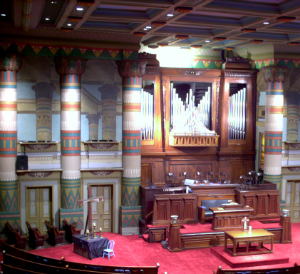Carol Howard Merritt: Revived by the Arts

Photos courtesy of Downtown Presbyterian Church
Walking into the sanctuary of Nashville's Downtown Presbyterian Church reminded me of a revival. The word revival has been used in many different ways in our religious history. Usually it refers to a preacher with great oratory skills who sweeps into town gathering thousands and transforming them with emotional pleas for personal repentance and ongoing dedication.
Downtown Presbyterian stokes a different sort of revival. I'd read about its unique place in architectural history. After two structures were destroyed by fire, William Strickland designed a building with the Egyptian Revival movement in mind. The year was 1848, and archaeological findings had kindled the imaginations of architects and furniture designers in Europe and the United States. The members of Downtown Presbyterian know that they are stewards of this movement and have preserved the church's art and windows.
As I approached the church, I was struck by the seeming incongruity of a traditional building embellished with bold chevron stripes and the illusion of a portico extending beyond the columns. Murals covered the walls, and I tried to decipher the symbolism of orbs with snakelike creatures descending from them. They reminded me of health textbook renderings of ovaries or of a nod to Ra. My eyes moved to the stained glass, where palm trees swayed over tinted circles.
|  |
|
Although the building is striking, the church members don't see themselves only as preservationists maintaining the revivals of the past. Instead they have harnessed that past creative energy for a present awakening by feeding the homeless, providing art classes for children, and maintaining an artist-in-residence program. This sort of revival forms sustainable movements of inspiration. Entire city blocks come alive with artistry.
As I followed artist-in-residence Cary Gibson up a circling staircase, she warned me about the unevenness of the ancient steps. The winding walls were painted a dark hue, but the paint failed to mask the decades of fingerprints left by people holding themselves steady as they ascended.
The circuitous route reminded me of Gibson's journey. Her Scottish parents raised her in England, then she spent 24 years living in Ireland. There she earned master's degrees in peace studies and women's studies, which makes her a keen observer of power dynamics. She became a collaborator in Ikon Belfast, a community that thrives on the edge of religion, employing visual and performance art in its gatherings. Gibson's longing for social justice spilled out in her energy, conversation, and collage work. As we talked we moved from global issues to southern racial history to local political minutiae.
At the top of the stairs, classrooms had been transformed into studios. Old glass panes had been assembled into archways that allowed light to flood into the spaces. Color freckled the wooden floors, and the high ceilings accommodated large art works. Spray paint cans lined the walls. Experimental canvases covered the desks. Inspiring words, colors, and textures hung on bulletin boards. Each studio had a wall that divided it from the next one, but there were no locking doors. Only cloth hangings or walls of pipes separated one studio from the next. There was space to create, along with accessibility and collaboration.
The work varied. The church made sure that its artists were a mixture of self-taught and trained. The result was a labyrinth of fascinating works-in-progress. One artist created Rorschach images from photographs or wigs in eerie insect-like arrangements. Another positioned gray-speckled spirals into dizzying cohesion. Acrylic paintings gave colorful depth to forms and figures, and photographs were punctuated with poignant quotes.
Gibson's work-hinged doors with the words of Martin Luther King Jr.-reminded me of the arc of justice, while her carefully constructed collages contained layers of meaning. Twelve-inch square canvases created a timeline that illustrated her winding personal journey. As she pointed to them her story opened up to me.
Each artist pays a small monthly fee for electricity and upkeep and gives back to the church during the year by teaching art classes, designing bulletins, painting door murals, organizing exhibits, or creating art for Lent. This summer the church was part of downtown Nashville's Art Crawl.
The congregation of a hundred members is in the midst of a pastoral transition, yet the members' creativity and compassion continue without interruption. As I left the building I realized that I'd been awakened to the sights, textures, sounds, and smells around me. I had the urge to pick up a brush.
Being at Downtown Presbyterian Church reminded me that being made in the image of a Creator God means that we are called to create. By allowing their history to inspire new work, its members are supporting a great awakening.
